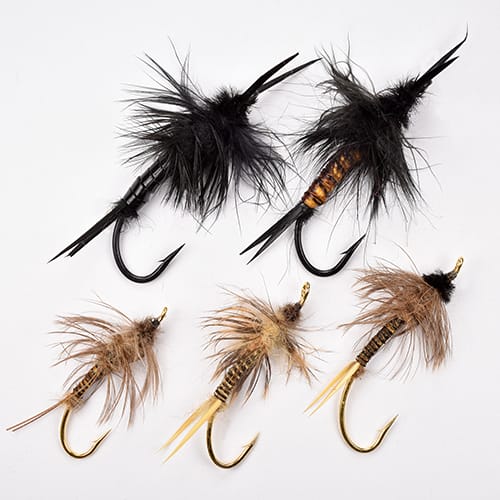Steelhead bites a fly – Why?
When selecting an artificial fly for trout fishing, anglers often attempt to “match the hatch”. Many at least offer some trout food representative in the river or creek. This makes fly selection somewhat easier but, unfortunately, this does not guarantee success. So, what about steelhead? Most angling literature tells us that like Pacific salmon, steelhead do not feed while in freshwater. But is this completely true?
The answer is “not exactly”. Steelhead fly anglers who have fished the Klamath and Trinity rivers in northern California are well aware the late summer/early fall half-pounder and adult steelhead bites a fly readily. Successful patterns are typically “buggier” when compared to patterns for Eel River winter steelhead. Why? The simple reason is the Klamath River late summer/early fall steelhead will actively feed while in freshwater.
Analyzing food habits
Many years ago, Brad Jackson, cofounder of The Fly Shop, while fishing the Klamath and caught an especially heavy fish. He kept the fish and upon cleaning it, noted the stomach contents contained a large number of mayfly nymphs. Brad placed the stomach contents in a glass bottle with alcohol. He later identified the nymphs as from the genus Isonychia. This mayfly is fairly common on several northern California and southern Oregon anadromous rivers.
Food habit studies of half-pounder steelhead demonstrate stonefly nymphs of the genus Acroneuria are commonly eaten. For many years I have had good success swinging imitations of both Acroneuria and the bigger Pteronarcys stonefly nymphs for Klamath River half-pounder and adult steelhead. Stonefly imitations fished on a floating Scandi shooting head and long leader work best. I make casts across the run and follow with an upstream mend. The fly drifts a short distance before coming under tension. Additional upstream mends will keep the fly drifting to some extent naturally and often steelhead bites a fly just after a mend.
Water Temperature
Fish are cold blooded creatures and their body temperature is the same as the surrounding water. A cold environment usually means a slower metabolism. However, cold water and a reduced metabolism do not mean winter steelhead are completely unresponsive. It does suggest a winter steelhead in 40o F. water will not be as responsive as a summer steelhead holding in 64o F. water. Unlike winter steelhead, summer steelhead are sexually immature when first entering freshwater. The often become “trout-like” during their freshwater residency period.
Streamflows
Catching fish improves as a result of storms and increased streamflows. Topher Brown in, Atlantic Salmon Magic (2011), suggested Atlantic salmon with higher levels of serum thyroxine (T4) were more apt to take an artificial fly. The thyroid gland produces the T4 hormone. He based his theory on studies that demonstrated increased water velocities were correlated with increased levels of thyroxine in Atlantic salmon and migration. He suggested the fish “are alert…and responsive to flies”. In fish, thyroid hormones affect metabolic processes and contribute to growth and development, metabolism, and osmoregulation. It also appears these hormones are involved in triggering migration. Brown may be correct in his assumption that increased stream flow, i.e. higher water velocities, are associated with increased migration and aggressiveness of Atlantic salmon. The same may be true of steelhead.
Elton Bailey, a California Department of Fish and Game Fisheries Biologist in the 1950’s, commented on the movement of winter steelhead in the Mad River. Bailey indicated adult steelhead migrated in response to water temperature changes rather than to fluctuations in river flow. Higher water temperatures will increase the fish’s metabolism and may also be a factor that encourages migration. River water temperatures will often change with rainfall or snow melt. Of interest to anglers, Bailey also reported migration occurred most often during periods of low light.
Smaller flies vs. Larger flies
Another part of the “why steelhead bite” puzzle deals with the fishes’ freshwater and marine feeding behaviors. Many steelhead anglers are convinced larger flies are more effective for winter steelhead soon after they enter freshwater. But as the season progresses, smaller flies become more effective. In the marine environment, prey items such as squid and small fishes are an important part of the steelhead’s diet. It is apparent after first entering freshwater, steelhead are not put off by large offerings. However, as the steelhead remains in freshwater, behavior appears to become more like during the fish’s juvenile freshwater rearing period.
Juvenile fish readily take both subsurface and surface items. Smaller offerings may be more representative of the food items such as stonefly and mayfly nymphs. The willingness of steelhead to take a fly may in fact relate to the fish’s freshwater feeding behavior. It may also help explain the lack of aggressiveness demonstrated by hatchery produced steelhead raised on a diet of commercial pellet food as compared to a wild juvenile fish that consumes a variety of natural prey items.
Which fly to use?
Steelhead anglers rely on a number of factors to determine which fly to use. Often previous success is the determining factor. Confidence also plays an important role for both fly selection and making effective presentations. The bottom line is to make fly selection for steelhead based on factors you can quantify. Some of these include –
- Time of day (light or dark),
- Water clarity (clear or discolored),
- Water level (low or high),
- Stream flow (increasing or dropping)
- Water temperature (cold versus relatively warmer),
- Type of water (slow versus moving),
- Fishing pressure (light versus heavy),
- Steelhead activity (migrating versus holding)
- Steelhead status (fresh, stale, time in freshwater, or actively feeding), and
- Barometric pressure
